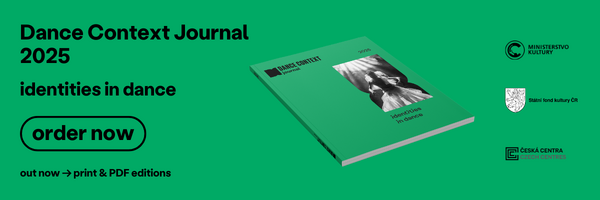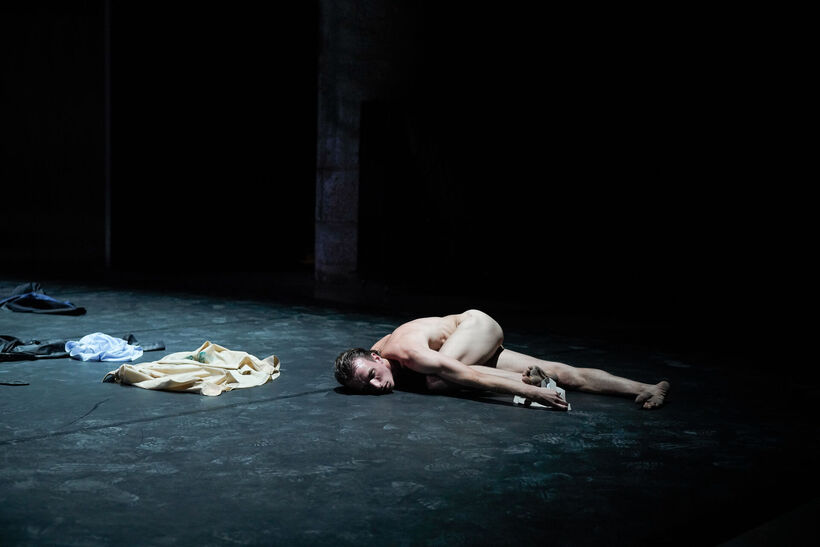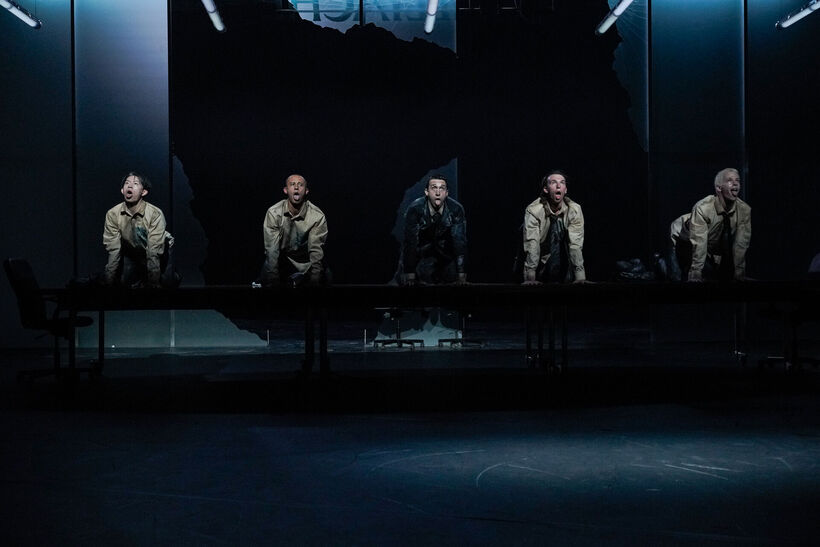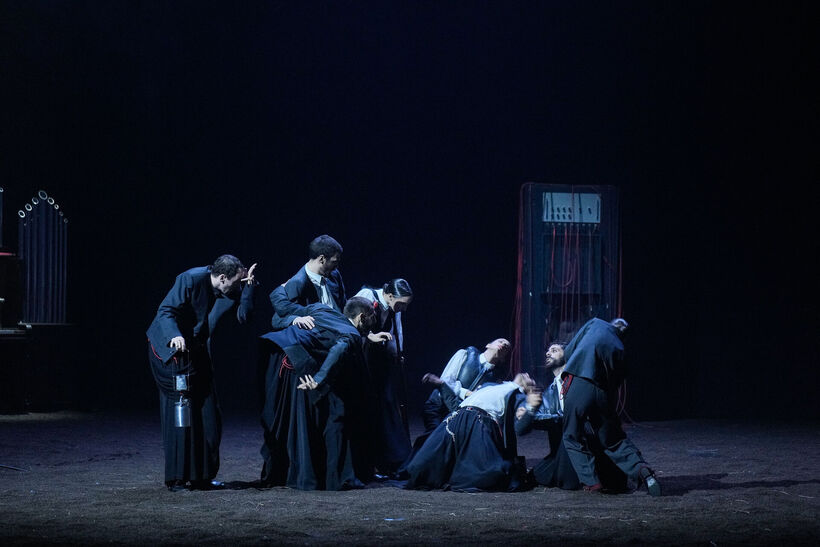The festival functioned as a critical laboratory, mapping contemporary fractures of the body on stage. The theme Myth Makers served less as a directive than as a lens: works rarely constructed myths outright, instead deconstructing and interrogating them, often through transcultural and feminist perspectives. Bodies became carriers of power, trauma, and discourse rather than instruments of aesthetic display, turning each performance into a meditation on the body’s negotiation within social and institutional frameworks.
Biennale Danza 2025 – Myth Makers: What Are Today’s Myths?
Biennale Danza 2025, Myth Makers, staged a landscape of tension and contradiction, where aesthetics collided with both implicit and overt politics. Dance, as a space where the social body can be inscribed—and reinscribed—was interrogated in every direction: exposed, manipulated, violated, and reanimated, with the stage itself acting as an archive. Movement, at times metaphorical, engaged with trauma, memory, and language, revealing both the intellectual rigor of the work and the persistent tension between research and performance. Here, the body was not merely present—it became a battlefield, a contemporary myth in motion.
Not everything ran smoothly: some curatorial choices felt procedural, and a few aesthetics leaned toward self-referentiality. The festival’s infrastructure faced glitches—technical hiccups, a reported hacker attack, and delays in press communications—echoing the on-stage exploration of visibility, access, and privilege. In this way, operational friction mirrored the festival’s thematic concerns: who performs, who observes, and who is allowed to matter.
As always, Biennale Danza awarded two Lions: the Golden Lion for lifetime achievement and the Silver Lion for emerging innovation. This year, both Lions went to women—a potent symbol. The Golden Lion honored American choreographer Twyla Tharp, a postmodern icon who blurred boundaries between high and low dance, musicals and minimalism, virtuosity and humor. The Silver Lion recognized Brazilian theater author and director Carolina Bianchi, a post-disciplinary artist weaving post-dramatic theater, performance, and writing into explorations of fragmented subjectivity. Two generations, two approaches, yet both reshaping the stage body: Tharp through precise choreographic grammar, Bianchi through hypertextual theater that spills into philosophy.
No Image Is Neutral, No Vision Innocent
A nearly four-hour work that interrogates the gaze as much as it commands attention, Carolina Bianchi’s The Brotherhood (2025)—the second chapter of the Cadela Forca trilogy—is a performative score in which flesh becomes language and the stage transforms into a living archive of violence. Drawing inspiration from anthropologist Rita Laura Segato’s studies of serial femicides in Ciudad Juárez, the work explores male “brotherhood”: tacit, enduring bonds that perpetuate abuse and violence. Bianchi avoids simplification, also examining women’s roles in perpetuating oppression, challenging assumptions of traditional feminism. Female complicity emerges as a symbol of unspoken participation.
The performance opens with cyclical, rhythmic music curated by Miguel Caldas, while a canvas of Rubens’ The Rape of Proserpina (1636) is swept aside as if by a whirlwind. A live camera documents performers as evidence: scenes of rape, drugged bodies, violated women. The body rarely acts autonomously; it is passive, dissected, more a vehicle for discourse than the protagonist of action. Though neutrality is impossible, the theoretical framework risks sterilizing the visceral experience.
Bianchi constructs a dense, layered dramaturgy—alternating pop aesthetics (commercial music, live camera) with scholarly references (Dante, Freud, Chekhov, Sarah Kane). Yet the overall effect can feel claustrophobic. Trauma, employed as artistic material, interrogates the structures surrounding rape rather than merely representing it. At times, the work resembles a staged doctoral thesis: language overwhelms gesture, and theater becomes self-referential.
Trauma—rape and the erasure of consent—is confronted directly, yet rarely translated into autonomous bodily action. The theoretical apparatus risks controlling rather than liberating. Bianchi’s theater spirals inward, sometimes imploding in the effort to articulate the inexpressible. Charisma and thematic weight are present, but dramaturgical balance wavers. After a compelling start and effective use of video, language becomes excessive, philosophy heavy, and the body retreats. Movement yields to verbalization. Here, feminism functions not as an object but as an invisible scaffold, perhaps suffocating the stage. Dance is largely absent, placing the work in a lateral position within the Biennale framework. While thematically powerful, The Brotherhood lacks the physicality needed to render dance a form of embodied resistance. Despite this, the Silver Lion recognizes a radical, courageous artist interrogating trauma with rigorous depth.
Who Are the Good Men?
If The Brotherhood thematizes trauma, A Good Man Is Hard to Find (2025) embodies it to excess. British collective BULLYACHE—Courtney Tylor Deyn and Jacob Samuel, winners of the international choreography grant—presents a disturbing, sexualized, ritualistic, punk-infused performance: a choreography of dysfunction and social performance.
The scene opens with a long office table under cold lighting. A man in a jacket observes another one who crawls semi-naked. Ave Maria resonates, interrupting ordinary everyday life, as a janitor enters—witness or martyr—embodying the spectator’s gaze and establishing immediate power dynamics. Gestures construct a queer, surreal dystopia, recalling DV8 and Pina Bausch while embracing a post-identitarian language. The table becomes altar, confessional, tribunal; shattered glass and a broken crucifix punctuate slow-motion crucifixions, falls, and offered bodies.
The visual and corporeal score references history and culture—from the 2008 financial crisis to Bohemian Grove, including nods to the Cremation of Care ritual. Performers alternate in portrait-dances resembling queer micro-biographies, interrogating desire, ritual, and social performance. The audience participates, often unknowingly, choosing which body is sacrificed. The final scene, where an altar is flooded with fake blood, selfies, and exposed vulnerability, becomes a profane mass, blending ritual, a spectacle with active participation of the audience, who were invited to choose the sacrificial victim, …but in reality, it was a fake, as it had clearly already been decided in advance.
BULLYACHE choreographs both bodies and devices, exposing sexual spectacle, fetishized pain, and theatricalized consent with irony and precision, in a deliberately “dirty” aesthetic. Technical mastery is exceptional, though dramaturgical pacing sometimes falters, making sequences feel overloaded. Clarifying structure and letting gestures breathe could heighten impact.
A Good Man Is Hard to Find exposes more than it saves. It is disorienting and powerful, deconstructing aesthetics of masculinity, faith, and performativity with fierce irony. Post-Bauschian and post-identitarian, it restores dance’s subversive potential, challenging the social body and spectatorship.
Elegance (Almost) Millimetric, Urgency Absent
One cannot help but admire the precision of Yoann Bourgeois Art Company’s, accompanied by Patrick Watson’s evocative music. The industrial zone of Marghera offers an ideal backdrop for this aesthetic of ruin and vertigo, yet the performance largely recycles familiar devices: jumps, stairs, rotations, gestures flirting with gravity without ever truly defying it.
Watson’s collaboration adds an atmospheric, poetic layer but does little to alter the overall impression: a mechanical dance of uncertainty that never truly loses balance. Bodies oscillate, fall, stop a millimeter from the ground, creating visually impeccable moments yet closed in on themselves. Bourgeois treats falling as a metaphor for instability, but from a position of absolute control: risk is implied, but aesthetic tension does not produce fractures.
In short: an almost perfect machine—elegant, seductive, technically flawless—but lacking poetic or emotional urgency. A dance that floats, fascinates, but does not interrogate.
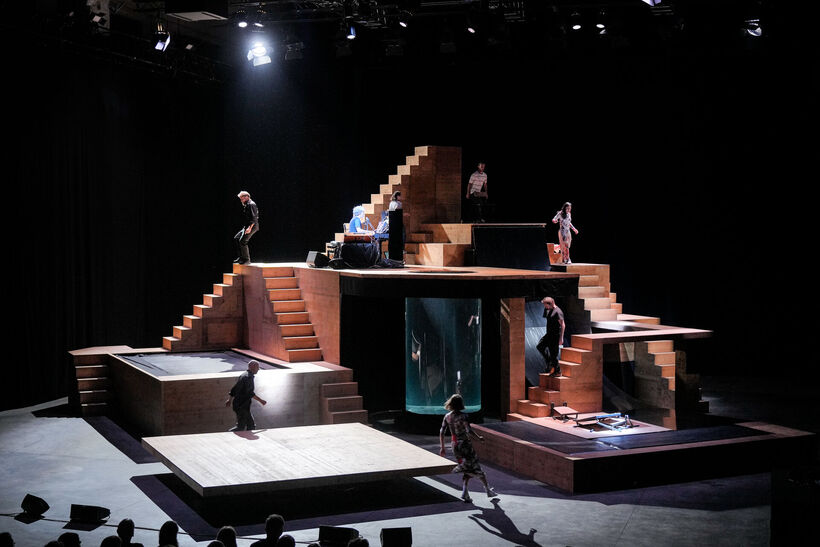.jpg)
Sisifo Felice (2025) is an ambitious project that seeks to merge the choreographic sensibilities of Philippe Kratz and Pablo Girolami—winner of the 2025 Biennale Danza grant for new Italian choreography—drawing inspiration from Albert Camus. Yet the result feels uneven: the promise of a mythological exploration risks being lost amid exercises in style and familiar references.
The first part of the performance relies on repetitive, accumulative sequences, an attempt to evoke Sisyphus’ myth—the ascent, the fall, the restart. Gestures layer and multiply but never reach a decisive breaking point, leaving a sense of narrative emptiness. The second part, more narrative-driven, recalls the aesthetics of Sharon Eyal, Marcos Morau, and Girolami himself (from the IVONA group), yet fails to transform these influences into a truly personal language.
The performers’ dance is impeccable: intense, precise, technically brilliant. But technical mastery alone cannot impart urgency or necessity to the choreography. The audience witnesses elegance turned inward, incapable of generating real ruptures or tension.
Who Dances When the Body Is No Longer There?
Wayne McGregor and Jeffrey Shaw’s interactive installation On the Other Earth (2025) challenges perception, immersing the spectator in an environment where the body is simultaneously real, virtual, and altered. One of the Biennale’s most compelling proposals, it expands dance beyond its physical presence, projecting it into digital space.
The installation creates a perceptual elsewhere in which the body multiplies, transforms, and abstracts—a ghostly dance that paradoxically restores corporeal presence to its most vivid form. McGregor and Shaw operate at the boundary of visibility and invisibility, proposing a choreography of codes, traces, and vibrations: a dance of data and reflection. Here, technology is not decoration but language; the machine becomes a poetic partner.
McGregor does not offer dance in space, but dance of space—a system of feedback, delays, and reflections questioning the very idea of presence. Far from the gimmicky “wow” effect of many immersive installations, here technology prompts reflection: on the memory of gesture, the disappearance of the author, and the nature of corporeal existence.
The installation transforms spectator into performer and gesture into code, offering an experience both destabilizing and poetic. Presence is no longer visible, yet profoundly felt. On the Other Earth explores metamorphosis, post-humanity, and radical otherness without cold conceptualism, revealing a tangible poetry in the absence of flesh. A dance that does not show, but evokes. Lucid, necessary, and thought-provoking.
Spring Is Not Waiting for You
Inspired by Mercè Rodoreda’s posthumous novel, Spanish choreographer Marcos Morau’s La Mort i la Primavera (2025) straddles concert, dance, and installation: an opaque, poetic, and cruel dream. On stage: a chair covered in earth, a mannequin-corpse, a pregnant woman hidden inside a tree trunk. These images evoke archetypes rather than narrative, suggesting rather than declaring. Dance does not represent—it surfaces and disappears. Time flows slowly, as suspended figures traverse a voiceless memory.
The work is full of visual and symbolic density: objects, sounds, lights, and presences multiply to form a dramaturgy of excess—almost baroque in its saturation. In this fullness, the poetic force risks being lost: the vertigo of images can overwhelm gesture. Still, within this excess lies Morau’s generosity: a will to translate life and death into total scenic form. A dance that promises no salvation but presence; form becomes trace. Deliberately unfinished, it thrives in the liminal, where it finds its strength.
If On the Other Earth dissolves the body into digital projection, Morau’s restores materiality—only to reveal its disintegration. Two poles: one technological and rarefied, the other organic and baroque. Yet both interrogate presence, redefining the body’s boundaries and language. McGregor constructs an elsewhere of light and code, where gesture becomes data and dance an invisible trace; Morau accumulates images and symbols to excess, seeking in saturation the truth of the living. In both, dance ceases to represent the body, reflecting instead on its disappearance and possible return. Two opposing poetics converge on the same question: what remains of the body when dance no longer contains it?
Once again, the Biennale catalog emerges as an indispensable companion: a curated universe of essays, reflections, and images that extend the festival into a laboratory of thought and mythopoiesis. Browsing its pages is a ritual of vision, a testament to dance as space where body, image, and intellect converge.
Written at the Biennale Danza Festival from 17 July to 2 August 2025.


